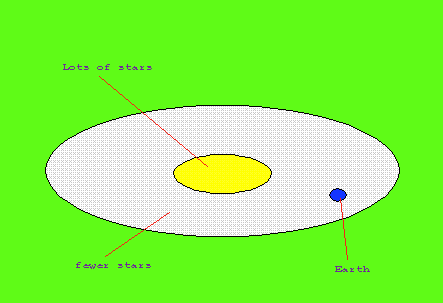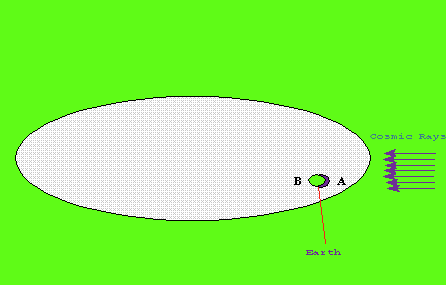
All the light and the heat which we receive on the Earth comes from the sun, so it might seem a reasonable guess to suspect that cosmic rays may also come from the sun. This however is not the case. There are two bits of experimental evidence which backs up this statement.
Firstly it is well known that during the day it is light and at night it is dark, in other words a variation of light intensity seen on Earth occurs during a day (24 hour cycle). Similarly the hottest part of the day occurs between 11am and 3pm, the coolest part occurring in the early hours of the morning. In other words there is a heat variation during the day. Based on these facts, it is reasonable to assume that if cosmic rays came from the sun, they too would have some daily variation in intensity. For example the intensity of cosmic rays received by the Earth would be large around lunchtime, and much less in the middle of the night. However no such variation is observed. Indeed the cosmic rays received by the Earth is rather constant at all times during the day.
The second reason why cosmic rays cannot come from the sun, is that the sun is not able to give out particles with the high levels of energy which cosmic rays are known to have.
Evidence also exists to suggest that cosmic rays cannot exist outside of our galaxy. In order to understand why this is so it is first necessary to consider what exactly our galaxy looks like.
The galaxy can be modelled as a 'fried egg':

Figure 1: Our 'fried egg' galaxy
The galaxy has a large number of stars at it's centre and fewer further out. In all our galaxy contains of the order 100,000 million stars. The Earth is found towards the edge of the galaxy. The galaxy is of a spiral shape and is rotating at 290km/s which is equivalent to 640,000mph. This means that all the stars and planets within the galaxy are also rotating. Therefore the Earth is rotating and moving through space, relative to neighbouring galaxies, with a speed of 640,000mph.
Let us briefly stop for a moment and consider how fast 640,000mph is. To get a rough idea, the maximum speed a car can legally travel in Britain is 70mph, 9143 times slower than the speed with which the Earth is moving through space. When Linford Christie broke the 100m world record a few years ago, he ran at a speed of 0.01km/s. Concorde moves a bit faster and can travel at 0.63km/s. Faster still is the speed at which chemicals from a chemical explosion are ejected. This happens at the order of 7.5km/s. Even so this speed is still almost 40 times slower than the Earth is moving through space.
Returning to the issue of cosmic rays coming from outside the galaxy, then the fact that the Earth is moving through space implies that the intensity of the cosmic rays coming from outside of space will be greater on the side of the Earth facing the direction from which the cosmic rays came.
To make this clearer, consider the diagram seen in figure 2. If cosmic rays come from outside of the galaxy, say travelling (as shown) from right to left, then the number of cosmic rays received on face A must be greater than the number received on face B, (as the purple cosmic ray intensity shadow shows)

Figure 2: Cosmic rays from outside of our galaxy?
Furthermore if cosmic rays come from outside of the galaxy the spatial position of cosmic ray intensity would change at different times during the day, due to the fact that the Earth is spinning on it's own axis. No such variation is observed. Indeed the cosmic ray intensity on all points on the Earth's surface are roughly the same, at all times during the day. Therefore it is thought cosmic rays have no spatial or time variation.
We conclude from these observations that the majority of cosmic rays must originate within our galaxy. The next question which inevitable follows is: where from within our galaxy do cosmic rays come from?
Some cosmic rays are formed from stars, but most come from Supernova explosions. As keen astronomers will know, a star evolves over about 1010 years. At the end of their lives some stars explode. These are called Supernova explosions. About 100 supernova explosions occur during one year, they are observed mostly by professional astronomers, although during February this year the 5th ever supernova explosion seen by an amateur was recorded.
When these supernova explosions occur they release atomic nuclei. These atomic nuclei are the source cosmic rays and are mostly hydrogen and helium nuclei. These source cosmic rays are known as Primary cosmic rays.
What are cosmic rays?
Return to the home page